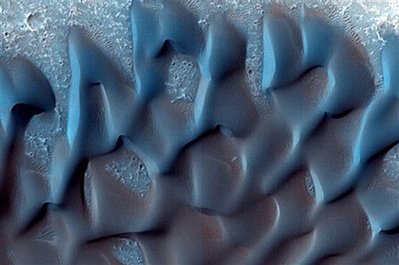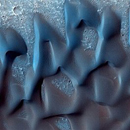Wind and Snow Do Strange Things on Mars
Space.com
September 18, 2008
Planetary scientists have discovered new details to explain a mysterious seasonal asymmetry of a Martian polar ice cap.
Like Earth, Mars has frozen polar caps, but unlike Earth, these caps are made of carbon dioxide ice as well as water ice. During the southern hemisphere's summer at Mars, much of the ice cap sublimates, a process in which the water ice turns straight back into gas, leaving behind what is known as the residual polar cap of mostly carbon dioxide ice (what we know as "dry ice").
While the winter cap is symmetrical about the red planet's south pole, the residual cap is offset by some three to four degrees. Scientists had proposed one explanation for this puzzling misplacement in 2005, suggesting that more snow fell in the polar region's western hemisphere during the winter. In that way, during the summer and spring seasons, some of the surface snow would remain on one side of the pole.
But now new details about the Martian weather suggest a slightly different mechanism for the wonky ice cap. The complex answer involves an odd interaction between wind, snow and the sun.
Snow and frost
The new study relied on information gleaned from the Planetary Fourier Spectrometer onboard the European Space Agency's Mars Express spacecraft.
Marco Giuranna of the Istituto di Fisica dello Spazio Interplanetario CNR in Rome, Italy, and colleagues measured temperature and other conditions of the Martian atmosphere above the south polar region, along with carbon dioxide accumulation in the southern ice cap.
They found the offsetting process starts with strong eastward winds at Mars' mid-latitudes that blow straight into the Hellas Basin, the largest impact structure on Mars with a diameter of 1,429 miles (2,300 km) and a depth of about 4 miles (7 km). The crater's steep walls deflect the winds and create giant waves in the atmosphere, which on Earth are referred to as Rossby waves. These waves reroute the high-altitude winds on Mars and force weather systems toward the south pole.
In the western hemisphere of Mars, the result is a strong low-pressure system near the south pole, and a high-pressure system in the eastern hemisphere, again near the south pole.
The low-pressure system in the western hemisphere makes for cooler air temperatures. And these temperatures are just right for carbon dioxide to condense into snow. That means in the western hemisphere of the south pole there is a buildup of both snow and frost.
In the high-pressure system in the eastern hemisphere, temperatures are always too warm for snow to fall, so only frost coats the ground there, Giuranna said.
Frost is found across the south polar region on Mars, regardless of hemisphere. "During the polar night [on Mars] you always have condensation of CO2 on the surface. I call it frost," Giuranna told SPACE.com. "When CO2 gas touches the surface it freezes instantaneously."
Sunlight's role
The story is not just one of more ice cover (from snow and frost), however.
The areas that have extensive snow cover reflect more sunlight back into space than does the surface frost. Grains of frost tend to be larger than snow grains and have rougher surfaces. With such rugged texture, the frost traps more sunlight, driving the sublimation.
So the western area of the southern polar cap, built of snow and frost, not only has a larger amount of carbon dioxide ice deposited but also sublimates more slowly during the summer. The western area built of frost disappears completely.
This explains why the residual cap is not symmetrically placed around the south pole, the researchers said.
The research is set to be published in a forthcoming edition of the journal Icarus.





 Share your thoughts in the Forum
Share your thoughts in the Forum
